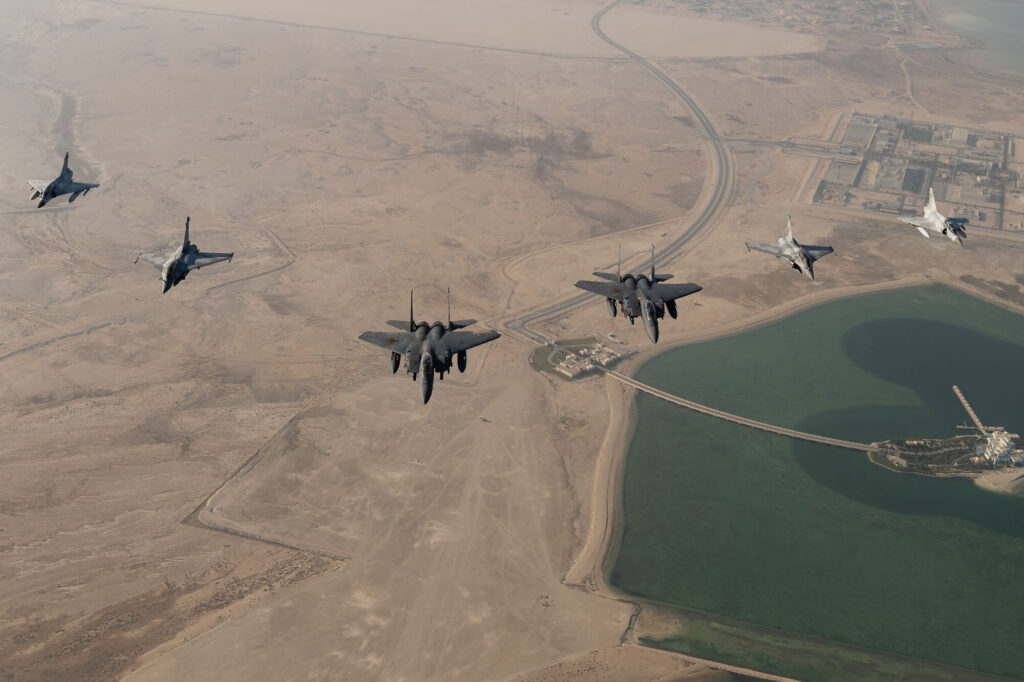Gulf countries have become leaders in the global arms market. This is largely because of two things: a tense geopolitical situation and significant wealth based on the export of oil.
But with barely a defense industry to call its own, weaponry found in the Gulf is largely composed of foreign material.
Interestingly, Saudi Arabia is considered to be the world’s largest importer of arms. So, it is not exactly surprising that the region has a respectable number of fighter jets at its disposal. However, a quick observation of Gulf fighter fleets reveals that all aircraft in the region are imported.
The Gulf has long been dominated by American suppliers. The bulk of operational fighter planes in the region are F-16 Fighting Falcon and F-15 Eagle jets. The Eagle entered the region early in its program. The first F-15 to be delivered to Saudi Arabia arrived in 1978, just two years after it was formally inducted by the United States Air Force.
Many years of operating such aircraft have seen Gulf forces become accustomed to handling American equipment. Subsequently, the region has become reliant on the US industry. This long-lasting relationship has also encouraged innovation by suppliers in a bid to meet growing demand.
The F-15QA is a variant that was specially developed for the Qatari Air Force (QEAF). It was derived from the F-15SA, which was designed for the Royal Saudi Air Force. The updated fighter jet features fly-by-wire controls, a digital cockpit, modernized sensors, radars, and electronic warfare capabilities. The aircraft served as the basis for a domestic version, the F-15EX, which was developed by Boeing for the United States Air Force.
While US manufacturers occupy an advantageous position in the region, the fluctuating diplomatic relationship between Gulf countries and Israel has led to some limitations regarding the lethality of weapon platforms offered by the United States.
The most recent incident unfolded hours before the inauguration of Joe Biden as president of the United States on January 21, 2021. A deal between the United Arab Emirates and the Trump administration was signed to procure 18 MQ-9B SeaGuardian drones and, more importantly, 50 Lockheed Martin F-35A stealth fighter jets.
A number of US lawmakers had previously protested against the sale, fearing that it would disrupt the power balance in the Middle East. Indeed, since 2008, any proposed US arms sale in the region must include a notification to Congress with a determination that the contract would not affect Israel’s “Qualitative Military Edge” over its neighbors. Until then, Israel was the only F-35 operator in the Middle East.
The transaction was suspended by Joe Biden once he took office, pending a review to ensure the contract met the “strategic objectives” of the US. In April 2021, Congress was notified that the sale was about to be greenlighted by the administration, though it would continue reviewing details, specifically the future use of the weapons.
As part of the normalization of diplomatic relations between Israel and several Gulf states, Israel Air Force Commander, Amikam Norkin, even stated that common training could be in the works. “It won’t be long before we see joint exercises with the Gulf air forces,” Norkin told the Israeli newspaper Maariv.
Conflicting interests, alongside the desire to not be reliant on a single country, has pushed Gulf countries to diversify their suppliers. If the bulk of fighter planes in service in the Gulf are F-16 Fighting Falcon and F-15 Eagle jets, then they have been joined throughout the years by other, mostly European, aircraft.
Saudi Arabia is a noteworthy example of this situation. In 1985, the region faced temporary opposition from the United States Congress to sell additional F-15 fighter jets. And so, the Gulf state was approached by the United Kingdom. The two countries established a partnership known as the Al-Yamamah arms deals. In total, the Saudis acquired 120 Panavia Tornados throughout the 1980s. The trust was renewed in 2005, with the order of 72 Eurofighter Typhoons.
The main air forces in the Gulf continue to modernize their fleet. But questions still remain. How will these countries be able to fly and maintain such a vast and varied array of fighters in the years to come?
For example, the Qatar Emiri Air Force (QEAF), which has 105 fighters either in service or on order, has a ratio of one fighter jet to 42 service members. In comparison, the Israeli Air Force has a ratio of one fighter to 127 personnel and the United States Air Force has one to 237.
As with procurement, Qatar had to turn to its western allies for training. While Boeing and Dassault are respectively in charge of training for the F-15QA and the Rafale, the Royal Air Force teaches Qatari pilots how to operate the Typhoon.
Qatar recently reached an agreement with Italy to use the International Flight Training School (IFTS), a joint initiative by the Aeronautica Militare and Leonardo, for basic training.
Similarly, during the last decade, 100 pilots from the Royal Saudi Air Force (RSAF) were taught to fly at RAF bases in the United Kingdom, according to the British Ministry of Defence. Foreign reliance has been essential to the RSAF since its creation. Additionally, hired pilots of the Pakistani Air Force trained Saudi personnel and even flew the first Saudi fighter jets, 40 British F.53 Lightnings, in the 1960s.

